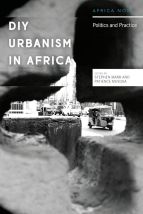DIY Urbanism in Africa: Politics and Practice

DIY Urbanism in Africa: Politics and Practice engages with the fascinating topic of DIY urbanism and draws on cases from sub-Saharan Africa to explore both the practical and political processes that African urban residents are employing to organize and navigate their lives in the city. The authors frame DIY urbanism as a form of auto-construction and resident-driven place-making; this includes both ‘makeshift’ urban infrastructure and the organization of health, leisure and security services, and is shaped by contextual possibilities and constraints that are often the result of State failure, infrastructure deficiency and/or economic precarity. Marr and Mususa highlight that this method of city-making becomes a vehicle for urban residents on the periphery (physically and socioeconomically) to, both by choice and out of necessity, fulfil their urban needs and hopes through experiential systems of knowledge-making and to become independent from unequal and exploitative structures. Their book approaches DIY urbanism therefore not as a category or system of fixed urban practice, but as a tool to explore varying self-driven urban initiatives and processes and to reflect on the future of urban politics in a world of widening inequalities and polarization and to probe the limits of DIY urbanism amidst global challenges and crisis. By looking at what DIY practices and processes are currently making African cities, Marr and Mususa aim to place this in conversation with other contexts and to act as a stepping stone towards thinking on wider global processes.
DIY Urbanism consists of twelve chapters enclosed by an introduction and ionclusion by Marr and Mususa. The introduction asks a number of questions including: what kinds of political agency does DIY urbanism produce; how is place-making approached by residents; what knowledge is acquired and how; what organizational structures are created to mobilize the agency of urban residents; how do these structures interact with the state; and is it reasonable for Africa’s urban residents to continue as primary makers and organisers of their cities and welfare? It further explores the history and mechanism of DIY urbanism specifically within the context of urban Africa and highlights both its strengths – of mobilizing a more inclusive democratic urban politics – and weaknesses – of being subverted for less democratic and inclusive politics and favouring interests of wealthy urban residents. Following this introduction, Chapters 1 to 4 expand a more theoretical debate and reflection around DIY urbanism: what it is; how it is formed and practised in the past and present; and what possibilities it holds for shaping urban processes. Chapters 5 to 12 proceed to utilize case studies from a variety of African cities, including Durban, Accra, Lagos, Freetown as well as cases from Malawi and Zambia, to explore different elements of DIY urbanism. These elements include: co-option processes; commoning through trespass and enclaving through privatizing; issues of social inclusivity; relational aspects of mobilization; impacts from colonial government; and potential for the state to tap into resources generated through DIY urbanism.
Through this array of case studies, Marr and Mususa illustrate that DIY urbanism consists of diverse associational arrangements for mobilizing provisioning services and infrastructure in Africa’s cities and that the underlying dynamics of DIY practices and organizational structures tend to be local. In their conclusion, they seek to engage with questions and themes that remain under-answered and aim to provoke rather than give definitive conclusions. As they reflect on earlier chapters, Marr and Mususa consider the works of Arendt and link her concept of action with DIY urbanism, considering if this connection helps to frame what urban residents are actually doing. They go on to explore the concepts of DIY and action and its connection to urban Africa through the three key characteristics of natality and boundlessness, unpredictability and acting together, and disruption and politics of presence. Marr and Mususa discuss the limitations to DIY politics and practices and further difficulties between DIY urbanism and our current greatest emergencies: climate change and COVID-19. To end, the authors flag three challenges they perceive, which they hope will guide future research paths and academic considerations of DIY urbanism.
This book provides an engaging resource for students and scholars of Africa, urban development, participatory and grassroots initiatives, and urban planning and politics among others. It is also valuable for practitioners with an interest in DIY urbanism and the potential marginalized people’ss agency holds for more inclusive urban planning and politics.
Book note prepared by Hannah Lee.
Search the Book notes database
Our Book notes database contains details and summaries of all the publications included in Book notes since 1993 - with details on how to obtain/download.
Use the search form above, or visit the Book notes landing page for more options and latest content.
For a searchable database for papers in Environment and Urbanization, go to http://eau.sagepub.com/

